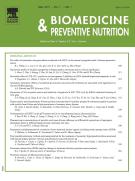Sulforaphane (SFN) regulates dedifferentiation and cyclooxygenase-2 (COX-2) expression via MAPkinase pathway in rabbit articular chondrocytes - 01/03/13

Abstract |
Sulforaphane (SFN), a member of the isothiocyanate family, is a biologically active compound extracted from cruciferous vegetables such as broccoli, cauliflower, radishes and cabbage. Although it possesses potent anti-inflammatory and anticancer properties, the specific effects and detailed mechanisms of SFN remain poorly understood. To investigate whether SFN regulates dedifferentiation and inflammation, chondrocytes were treated with SFN, which induced dedifferentiation and reduced inflammation, as indicated by the reduction of type II collagen and cyclooxygenase-2 (COX-2) in a dose- and time-dependent manner, as determined by Western blot analysis and RT-PCR. Synthesis of sulfated proteoglycan and production of prostaglandin E2 (PGE2) were decreased by treatment of SFN, as was detected by Alcian blue staining and immunohistochemical staining, and immunofluorescence staining and PGE2 assay, respectively. Additionally, treatment of SFN stimulated activation of mitogen-activated protein kinases (MAPKs), extracellular signal-regulated-kinase (ERK-1/2) and p38 kinase. Inhibition of ERK-1/2 with PD98059 rescued SFN-induced a loss of type II collagen expression, whereas inhibition of p38 kinase with SB203580 recovered SFN-reduced COX-2 expression, as determined by the Western blot analysis, immunohistochemical staining and immunofluorescence staining. Taken together, these results indicate that SFN regulates type II collagen via ERK-1/2 and COX-2 expression via p38kinase in rabbit articular chondrocytes.
Le texte complet de cet article est disponible en PDF.Keywords : Sulforaphane (SFN), Dedifferentiation, Cyclooxygense-2 (COX-2)
Abbreviations : SFN
Plan
Vol 3 - N° 1
P. 91-97 - janvier 2013 Retour au numéroBienvenue sur EM-consulte, la référence des professionnels de santé.
L’accès au texte intégral de cet article nécessite un abonnement.
Déjà abonné à cette revue ?

